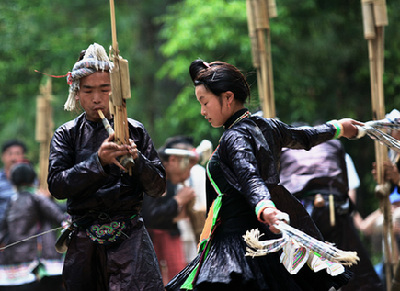Five Characteristics of Guangxi Ethnic Culture
Dancing
"Dancing" is an important form of ethnic culture and a kind of folk activity in Guangxi. There are various kinds of dances, like the bronze-drum dance of Zhuang, Yao and Yi people and Lu Sheng Dance (a dance with the accompaniment of a reed-pipe wind instrument) of Dong, Miao and Yi people.

Zhuang people usually perform Bian Dan Dance (a dance about agricultural work), Bamboo Dance, Chun Niu Dance (a dance of "Praying for harvest"), Lion Dance and Dragon Dance. Yao people usually perform Huang Ni Gu Dance (a dance with the accompaniment of a drum on which yellow mud is smeared). Dong people usually perform Duo Ye Dance (a collective dance). Gelao people usually perform Niu Jin Dance (a dance of "Praying for good health and a long life"). There are festivals named after "dancing", like Tiao Pan Wang (Pan Wang Jie) and Tiao Gong festival (a dance festival for Yi people to celebrate victory).
Huang Ni Gu Dance performed during Pan Wang Jie is representative of Guangxi dances. It used to be performed for offering sacrifices to Pan Wang.
Dancers play two kinds of drums — a small, long drum (also known as Wen Chang Gu or Hua Gu) and a big, long drum (commonly referred to as Huang Ni Gu or Wu Chang Gu). The smaller drum is played in a soft, deft way, while the big one is played in a vigorous way. Both drums match up with fixed tunes and lyrics in a uniform rhythm.
Accompanied with songs, the dance usually presents daily work, including building houses, making drums, cutting into a mountain, turning the sod and husking rice.
Dancers play the drums in a sophisticated and consummate way with various postures called "36 sets and 72 levels". Dancing postures can be divided into Gao Zhuang (turning the drum above the head), Zhong Zhuang (turning the drum on the belly) and Ai Zhuang (turning the drum at the knees).
The dance fully displays the exquisiteness of the Yao "dancing" culture. "Dancing" is the second element of Guangxi ethnic culture.














